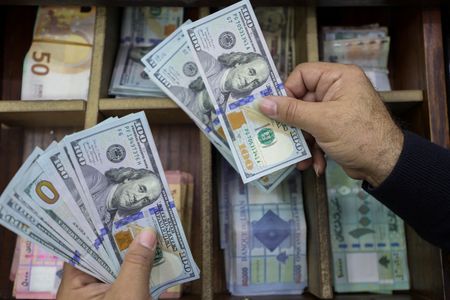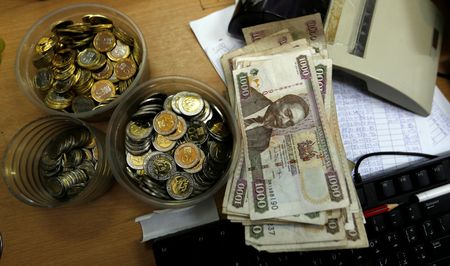By Lawrence Delevingne and Samuel Indyk
BOSTON/LONDON (Reuters) -U.S. technology shares dropped sharply on Monday as surging interest in Chinese startup DeepSeek’s low-cost artificial intelligence model raised doubts about the sector’s lofty valuations.
The tumble in global equities prompted a widespread flight to safety, with U.S. government bonds rising and safe-haven currencies – the yen and Swiss franc – surging.
DeepSeek, which overtook rival ChatGPT to become the top-rated free application on Apple’s App Store in the U.S., says it uses lower-cost chips and less data, challenging a widespread bet in markets that AI will drive demand along a supply chain from chipmakers to data centers.
On Wall Street, the Dow Jones Industrial Average fell 0.15%, to 44,358, the S&P 500 dropped 1.8%, to 5,991 and the Nasdaq Composite slumped about 3%, to 19,360.
Nvidia <NVDA.O>, whose chips are the top choice for powering AI applications, dropped about 15% on the day in line with industry peers Broadcom <AVGO.O> and Marvell Technology <MRVL.O>.
The CBOE Volatility Index, known as Wall Street’s “fear gauge”, hit its highest level since Dec. 20, surging 25% on the day.
“The catalyst of a foreign competitor to U.S.-led AI dominance begs other questions about trade and semiconductor chips and energy needs,” Robert Savage, head of markets strategy and insights at BNY, wrote in a note. “The markets are unsettled, and volatility is higher after last week’s strong returns.”
In Europe, the pan-European STOXX 600 index was little changed, but the STOXX Europe 600 technology index fell 3%, its biggest one-day drop since mid-October. MSCI’s gauge of stocks across the globe fell 1.25%.
BROAD RISK-OFF MOOD
U.S. Treasury yields tumbled to multi-week lows on Monday, tracking steep declines in equities, as investors sought the safety of government bonds. The benchmark U.S. 10-year yield dropped 7.7 basis points (bps) to 4.546%.
That pushed the dollar lower, with safe-haven currencies as the main beneficiaries.
“Haven demand has spilled over into FX,” said Shaun Osborne, chief FX strategist at Scotiabank.
“Part of the dollar’s slippage can be accounted for by the sharp fall in bond yields,” Osborne added.
The dollar fell 1.1% against the yen and 0.6% against the Swiss franc, two currencies that often gain during periods of market unease.
The dollar index, which measures the U.S. currency against six peers, fell 0.4% to its lowest level since Dec. 18.
U.S. import tariffs remain a key theme in markets, with President Donald Trump so far refraining from implementing broad trade levies.
China, Mexico and Canada are still facing a nervy wait after Trump last week earmarked Feb. 1 for additional tariffs on top trading partners.
The U.S. dollar rose around 1.7% against the Mexican peso but was little changed against its Canadian counterpart and the Chinese yuan in offshore trading.
The dollar also rose 1.26% against the Colombian peso after a short-lived spat over deportations.
On Sunday, Trump threatened Colombia with tariffs and sanctions to punish it for refusing to accept military flights carrying deportees, but Colombia later said it would accept repatriation flights and the U.S. sanctions threat was put on hold.
The market volatility on Monday kicks off a busy week in which both the U.S. Federal Reserve and the European Central Bank meet to set interest rates.
Oil prices edged lower on Monday as the deal with Colombia reduced immediate concern over oil supply disruptions, though Trump’s muscle-flexing is keeping markets twitchy.
U.S. crude fell 1.81% to $73.31 a barrel and Brent dropped to $77.21 per barrel, down 1.64% on the day.
Gold fell 1.14% to $2,739 per ounce.
Leading cryptocurrency bitcoin slumped more than 3.9%, dropping below $100,000 for the first time in a week, before bouncing to trade at $100,974.
(Reporting by Lawrence Delevingne in Boston and Samuel Indyk in London; Additional reporting by Davide Barbuscia in New York: Editing by Christina Fincher, Paul Simao and Kevin Liffey)









